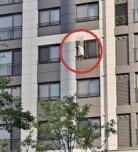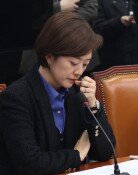Euthanasia Patient Alive After Respirator Removed
Euthanasia Patient Alive After Respirator Removed
Posted June. 25, 2009 09:06,
An elderly woman who is expected to be the countrys first euthanasia case was alive yesterday after her respirator was removed Tuesday.
As of 2 p.m., Kim Ok-gyeong, 77, had normal vital signs similar to those before the removal of the respirator, according to Yonsei Severance Hospital in Seoul. Her oxygen saturation was at 96 percent (the normal level is 95 percent and above), a heart rate of 92 (the normal range is 60 to 100) and a respiratory rate of 16 to 19 (the normal rate is 18).
Hospital director Park Chang-il said, The patient will face the most critical time over the next two weeks or a month, adding, If she survives until then, her status will be raised to the third phase under the guideline for death with dignity, in which a patient is in a coma but can breathe on his or her own.
The initial expectation was that Kim would die within three hours after her respirator was removed. Her survival has raised doubt over the Supreme Courts judgment that she faces imminent death. Based on its ruling May 21, the court had ordered Kims respirator removed.
Park said, I understand that the Supreme Court based its judgment on a medical assessment submitted by two hospitals that said Kims death was imminent, adding, At that time, we made clear that Kim was unable to breathe on her own but was not facing imminent death.
Kim remains alive because she can breathe on her own. The hospital, however, said it is premature to say her condition has stabilized.
Her attending physician Park Moo-seok said, If an elderly patient in critical condition develops pneumonia, he or she can die within a day or two, adding, A patient bedridden for a long time can develop blood clots and die suddenly of a heart attack and arrhythmia.
The hospital said it will take at least two weeks or a month for Kims condition to stabilize.
The biggest threat to the patient is sputum that can lead to pneumonia. When she was on a respirator, the medical staff could remove sputum accumulated below bronchus through suctioning. Now, only the sputum above bronchus can be removed, however.
The accumulation of sputum can block bronchus, which results in an increase in germs and eventual development of pneumonia. The hospital is performing sputum suction for Kim every one or two hours.
Unlike an intensive care unit, people can frequently visit the ward where Kim is. This raises the possibility of infection.
Park said, To prevent infection, we will keep people away as much as possible, adding, To prevent food from making its way into her lungs, we pay special attention when feeding her.
The hospital is providing Kim with regular nutritional treatment and said she suffered no damage to her heart and kidneys. Under the court ruling, however, the hospital cannot reattach her respirator or perform surgery even if she suffers difficulty breathing.
The court ruling and the Kim familys will are to remove a respirator from Kim. So we cannot perform medical treatment and violate the ruling, Park said, adding, Instead, we will continue emergency care such as giving medication.
likeday@donga.com baron@donga.com
Headline News
- Medical school quotas expanded after 27 years by 1,509
- ‘Pension replacement rate of 44-45% is negotiable,’ says Lee Jae-myung
- 16 out of 20 food companies see cost ratio decrease in 1st quarter
- Oksana Chusovitina with 8 Olympics under her belt gets injured
- Real income effectively reduced amid inflation hikes







